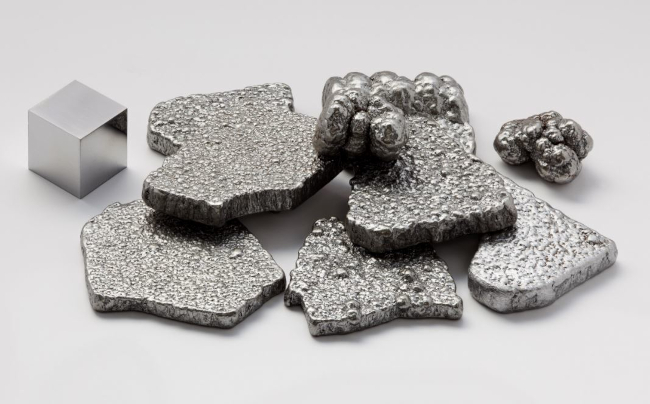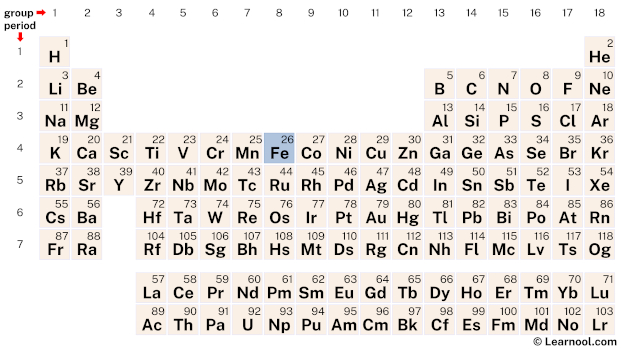
Iron (Fe) is a chemical element of the periodic table, located in the group 8 and the period 4, and is having the atomic number 26. It is a ductile, lustrous, silvery-grey transition metal, whose name comes from the Anglo-Saxon word “iren”. It is the cheapest metal and is the fourth most abundant element on earth.
On periodic table
| group | ⇨ | 1 | 2 | 3 | 4 | 5 | 6 | 7 | 8 | 9 | 10 | 11 | 12 | 13 | 14 | 15 | 16 | 17 | 18 |
| period | ⇩ | ||||||||||||||||||
| 1 | 1 H  Hydrogen |
2 He  Helium |
|||||||||||||||||
| 2 | 3 Li  Lithium |
4 Be  Beryllium |
5 B  Boron |
6 C  Carbon |
7 N  Nitrogen |
8 O  Oxygen |
9 F  Fluorine |
10 Ne  Neon |
|||||||||||
| 3 | 11 Na  Sodium |
12 Mg  Magnesium |
13 Al  Aluminium |
14 Si Silicon |
15 P  Phosphorus |
16 S  Sulfur |
17 Cl  Chlorine |
18 Ar  Argon |
|||||||||||
| 4 | 19 K  Potassium |
20 Ca  Calcium |
21 Sc  Scandium |
22 Ti  Titanium |
23 V  Vanadium |
24 Cr  Chromium |
25 Mn  Manganese |
26 Fe Iron |
27 Co  Cobalt |
28 Ni  Nickel |
29 Cu  Copper |
30 Zn  Zinc |
31 Ga  Gallium |
32 Ge  Germanium |
33 As  Arsenic |
34 Se  Selenium |
35 Br  Bromine |
36 Kr  Krypton |
|
| 5 | 37 Rb  Rubidium |
38 Sr  Strontium |
39 Y  Yttrium |
40 Zr  Zirconium |
41 Nb  Niobium |
42 Mo  Molybdenum |
43 Tc  Technetium |
44 Ru  Ruthenium |
45 Rh  Rhodium |
46 Pd  Palladium |
47 Ag  Silver |
48 Cd  Cadmium |
49 In  Indium |
50 Sn  Tin |
51 Sb  Antimony |
52 Te  Tellurium |
53 I  Iodine |
54 Xe  Xenon |
|
| 6 | 55 Cs  Caesium |
56 Ba  Barium |
72 Hf  Hafnium |
73 Ta  Tantalum |
74 W  Tungsten |
75 Re  Rhenium |
76 Os  Osmium |
77 Ir  Iridium |
78 Pt  Platinum |
79 Au  Gold |
80 Hg  Mercury |
81 Tl  Thallium |
82 Pb  Lead |
83 Bi  Bismuth |
84 Po  Polonium |
85 At  Astatine |
86 Rn  Radon |
||
| 7 | 87 Fr  Francium |
88 Ra  Radium |
104 Rf  Rutherfordium |
105 Db  Dubnium |
106 Sg  Seaborgium |
107 Bh  Bohrium |
108 Hs  Hassium |
109 Mt  Meitnerium |
110 Ds  Darmstadtium |
111 Rg  Roentgenium |
112 Cn  Copernicium |
113 Nh  Nihonium |
114 Fl  Flerovium |
115 Mc  Moscovium |
116 Lv  Livermorium |
117 Ts  Tennessine |
118 Og  Oganesson |
||
| 57 La  Lanthanum |
58 Ce  Cerium |
59 Pr  Praseodymium |
60 Nd  Neodymium |
61 Pm  Promethium |
62 Sm  Samarium |
63 Eu  Europium |
64 Gd  Gadolinium |
65 Tb  Terbium |
66 Dy  Dysprosium |
67 Ho  Holmium |
68 Er  Erbium |
69 Tm  Thulium |
70 Yb  Ytterbium |
71 Lu  Lutetium |
|||||
| 89 Ac  Actinium |
90 Th  Thorium |
91 Pa  Protactinium |
92 U  Uranium |
93 Np  Neptunium |
94 Pu  Plutonium |
95 Am  Americium |
96 Cm  Curium |
97 Bk  Berkelium |
98 Cf  Californium |
99 Es  Einsteinium |
100 Fm  Fermium |
101 Md  Mendelevium |
102 No  Nobelium |
103 Lr  Lawrencium |
|||||
| – d block |
Iron is a d-block element, situated in the eighth column and the fourth row of the periodic table. Its atomic number is 26 and its symbol is Fe.
Element information
 |
|
 |
|
| Origin of name | Anglo-Saxon word “iren” |
| Symbol | Fe |
| Atomic number (Z) | 26 |
| Atomic mass | 55.845 u |
| Block | d-block |
| Group | 8 |
| Period | 4 |
| Classification | Transition metal |
| Atomic radius | 126 pm |
| Covalent radius | Low spin: 132±3 pm High spin: 152±6 pm |
| Van der Waals radius | 194 pm |
| Melting point | 1538 ℃, 2800 ℉, 1811 K |
| Boiling point | 2862 ℃, 5182 ℉, 3134 K |
| Electron configuration | [Ar] 3d6 4s2 |
| Electrons per shell | 2, 8, 14, 2 |
| Learn how to draw: Iron Bohr model | |
| Crystal structure | Body-centered cubic (bcc) (a=286.65 pm) Face-centered cubic (fcc) (between 1185-1667 K; a=364.680 pm) |
| Phase at r.t | Solid |
| Density near r.t | 7.874 g/cm3 |
| Main isotopes | Iron-54, Iron-56, Iron-57, Iron-58 |
| Natural occurrence | Primordial |
| Oxidation state | +2, +3 |
| Electronegativity (Pauling scale) | 1.83 |
| Protons Neutrons Electrons |
26 30 26 |
| Learn how to find: Iron protons neutrons electrons | |
| CAS number | 7439-89-6 |
| Discovered by | Hittites of ancient Egypt around 3500 BC |
History
The history of iron can be traced back to ancient times, where it was first discovered and used for various purposes.
Iron was first discovered in Ancient Egypt in around 2500 BCE. It was used to make tools and weapons, including knives, swords, and chariots. Iron was also used in the construction of buildings, including the pyramids. The Hittites of Anatolia (modern-day Turkey) were the first to smelt iron around 1500 BCE, which led to a major shift in the production of weapons and tools.
Iron continued to be an important material throughout the ages. The Romans used it for construction, including building bridges and aqueducts. Iron was also used to make weapons and armor during the Middle Ages. In the 17th century, iron became an important material in the Industrial Revolution, which led to the mass production of iron goods.
Iron is a critical component of steel, which is an alloy of iron and carbon. The development of steel in the 19th century allowed for even greater industrialization and expansion of technology.
Iron has also played an important role in human health. Iron is an essential nutrient for humans, as it is a key component of hemoglobin, which is the protein in red blood cells that carries oxygen throughout the body. Iron deficiency can lead to anemia, a condition where the body doesn’t have enough red blood cells. Iron supplements and fortified foods can help to prevent and treat iron deficiency.
Occurrence and production
Iron is the fourth most abundant element in the Earth’s crust, accounting for about 5% of the total. Iron is typically found in minerals such as hematite, magnetite, and taconite. These minerals are usually found in rocks and soils and can be extracted through mining.
The production of iron typically involves the use of blast furnaces, which are large, cylindrical structures used to extract iron from its ores. The process involves heating iron ore with coke and limestone in a furnace to produce pig iron. The pig iron is then refined into steel, which is used in a wide range of applications.
In recent years, there has been a trend towards the use of alternative methods for the production of iron. One such method is direct reduction, which involves the use of a reducing agent to remove oxygen from iron ore. Direct reduction is becoming increasingly popular due to its lower energy requirements and environmental benefits.
Another method of producing iron is through the use of electric arc furnaces. This method involves melting scrap steel and iron to produce new steel products. Electric arc furnaces are more energy-efficient than blast furnaces and are often used to produce specialty steels.
Properties
Physical properties
Iron is a silvery-gray, lustrous metal that is ductile, malleable, and magnetic. It has a melting point of 1538 ℃ and a boiling point of 2862 ℃, making it a relatively high-temperature element. Iron is the sixth most abundant element in the universe, and the most common metal on Earth.
Chemical properties
Iron is a relatively reactive metal that reacts with oxygen in the air to form iron oxide, commonly known as rust. Rusting can be prevented by coating the iron with a layer of paint, oil, or other protective material. Iron also reacts with most acids, forming salts and hydrogen gas.
Iron is a transition metal, which means that it can form multiple oxidation states. Iron has two common oxidation states: +2 and +3. The +2 oxidation state is the most common and is found in many of the compounds of iron, including iron(Ⅱ) sulfate and iron(Ⅱ) chloride. The +3 oxidation state is found in compounds like iron(Ⅲ) oxide and iron(Ⅲ) chloride.
Applications
Steel production
Iron is a key component of steel, which is widely used in construction, transportation, and manufacturing. Steel production accounts for the majority of iron consumption worldwide.
Construction
Iron is used in the construction industry for structural support and reinforcement, such as in the form of steel beams and rebar.
Transportation
Iron and steel are used in the transportation industry for vehicles, ships, and aircraft, due to their strength and durability.
Machinery
Iron and steel are used in the production of machinery, including engines, turbines, and heavy equipment.
Cookware
Cast iron cookware is popular due to its ability to retain heat and its durability.
Medicine
Iron is an essential nutrient for humans and is used in the production of medications, such as iron supplements and intravenous iron.
Art
Iron is used in the production of art, such as sculptures and decorative objects.
Magnetic materials
Iron is a magnetic material and is used in the production of magnets, such as those used in motors and generators.
Electrical wiring
Iron and steel are used in the production of electrical wiring and other components due to their conductivity and durability.
Interesting facts
Iron is the fourth most abundant element in the Earth’s crust, making up about 5% of the total.
Iron is essential for life and is found in every living cell in the human body. It is a key component of hemoglobin, the protein that carries oxygen in the blood.
The word “iron” comes from the Old English word “iren,” which means “metal of earth.”
Iron has been used by humans for thousands of years, dating back to the Bronze Age.
Iron is the most commonly used metal in the world, and the production of steel accounts for the majority of iron consumption.
Iron is a magnetic material and is used in the production of magnets, including those used in motors and generators.
Iron has a high melting point of 2800 degrees Fahrenheit (1538 degrees Celsius).
Iron is a reactive element and can form many different compounds, including rust, which is a common form of iron oxide.
Iron is found in meteorites, and some scientists believe that the Earth’s core is made mostly of iron.
Iron is used in a wide range of applications, from construction and transportation to medicine and art.
Related
More elements
External links
- https://www.rsc.org/periodic-table/element/26/iron
- https://www.britannica.com/science/iron-chemical-element
- https://en.wikipedia.org/wiki/Iron
- https://pubchem.ncbi.nlm.nih.gov/element/Iron
- https://www.livescience.com/29263-iron.html
- https://www.thoughtco.com/iron-facts-606548
- https://www.chemicool.com/elements/iron.html
- https://chemistrytalk.org/iron-element/
Deep
Learnool.com was founded by Deep Rana, who is a mechanical engineer by profession and a blogger by passion. He has a good conceptual knowledge on different educational topics and he provides the same on this website. He loves to learn something new everyday and believes that the best utilization of free time is developing a new skill.
